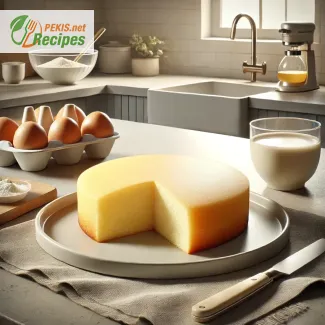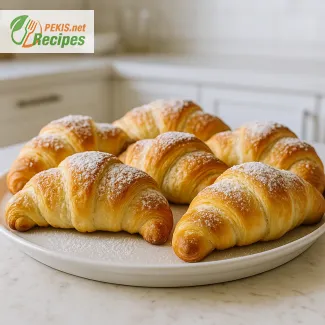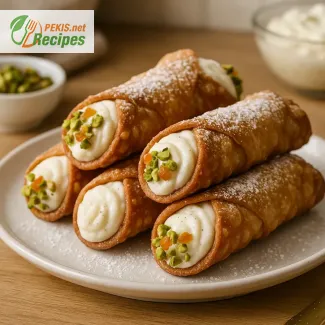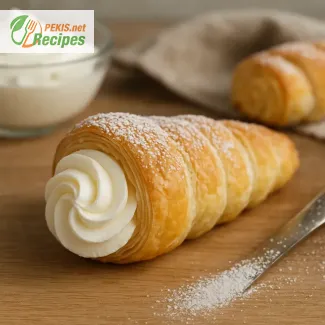
A fluffy cake sponge forms the foundation of nearly every memorable dessert, bringing lightness, moisture, and a perfectly airy texture to layered cakes, roulades, and delicate pastries. This classic component, essential in both professional patisseries and home baking, is prized for its subtle balance of structure and softness. Achieving the perfect sponge, one that’s soft yet resilient enough to hold its shape while embracing a variety of fillings and frostings, is a skill worth mastering for any baker. The right fluffy sponge elevates a dessert from ordinary to unforgettable, creating a textural contrast that pairs exquisitely with everything from silky buttercreams to fresh fruits and rich ganaches.
Crafted with just a few simple ingredients—eggs, sugar, flour, and a hint of vanilla—the secret to a perfect sponge lies in the technique. It’s not simply about mixing ingredients; it’s about the art of incorporating air into the batter. This allows the sponge to rise to its full potential, creating that soft, cloud-like texture that melts on the tongue. Professional bakers know that achieving this texture means whipping the eggs to a precise volume and gently folding in the flour to avoid deflating the batter. The result? A sponge that’s both delicate and elastic, ideal for slicing and layering without crumbling under pressure.
Unlike denser cakes, a fluffy sponge’s lightness serves as a blank canvas that absorbs flavors without overwhelming them. This versatility makes it a favorite in creating a wide array of cakes, from the luxurious Italian Tiramisu to the elegant French génoise and the Japanese-style sponges famous for their remarkable softness. When layered, the sponge provides a delicate foundation that allows the flavors of fillings—whether fruit preserves, whipped cream, chocolate ganache, or custard—to take center stage. The simplicity of a good sponge highlights the quality of these ingredients, ensuring each bite is a harmonious blend of flavors and textures.
A fluffy cake sponge is as practical as it is delicious. It maintains its structure when sliced, making it ideal for creating multi-layered masterpieces and intricate designs. Its ability to hold moisture without becoming soggy means it can be prepared ahead of time, even improving in flavor as it rests and absorbs the essence of surrounding ingredients. For bakers looking to add a professional touch, the sponge’s texture pairs beautifully with decorating techniques, like glazing, frosting, and drizzling with syrups.
In today’s world, where classic recipes meet modern dietary needs, the cake sponge has evolved. Many professional bakers are experimenting with gluten-free and dairy-free versions, allowing those with dietary restrictions to enjoy the delicate texture of this beloved cake base. Additionally, using natural sweeteners and organic flours elevates its profile for a health-conscious audience while maintaining the iconic, airy bite that defines a well-crafted sponge.
The joy of a fluffy cake sponge lies not only in its taste and texture but also in its versatility and universal appeal. From birthday celebrations to weddings, or simply as a comforting dessert with a cup of tea, a fluffy sponge cake is a dessert that transcends occasions. Its classic, unpretentious nature makes it a favorite among both novice bakers and seasoned professionals. When baked to perfection, it’s more than just a cake; it’s a symbol of the art of baking, where a few simple ingredients, handled with care and expertise, transform into something light, elegant, and deeply satisfying. This humble yet essential component continues to inspire bakers worldwide, inviting them to create, innovate, and, most importantly, enjoy every soft, pillowy bite.
- Prepare the Pan: Preheat your oven to 180°C (350°F). Grease a 20 cm (8-inch) round cake pan and line it with parchment paper.
- Whisk the Eggs: In a large bowl, combine the eggs and sugar. Using an electric mixer, beat the mixture on high speed for 8-10 minutes, or until it becomes pale, thick, and triples in volume. This step is crucial for achieving a fluffy texture.
- Add Vanilla and Salt: Gently fold in the vanilla extract and salt, being careful not to deflate the whipped eggs.
- Sift and Fold in Dry Ingredients: Sift together the flour and baking powder. Gradually add the dry ingredients to the egg mixture by gently folding with a spatula in three parts. Be careful not to overmix; otherwise, the batter will lose its airy structure.
- Shape the Batter: Pour the batter into the prepared cake pan and smooth the top.
- Bake: Bake in the preheated oven for 25-30 minutes, or until a toothpick inserted into the center comes out clean.
- Cool: Allow the cake to cool in the pan for 10 minutes, then transfer to a wire rack to cool completely before slicing or decorating.
Creating the perfect fluffy cake sponge relies on mastering the balance of ingredients, techniques, and small adjustments. Here are some professional tips and tricks to enhance the recipe, achieve the best results, and adapt it to meet specific needs.
1. Choosing the Right Flour:
- All-Purpose vs. Cake Flour: While all-purpose flour works well for this recipe, using cake flour can take the lightness and fluffiness of the sponge to another level. Cake flour has a lower protein content, which results in a finer, softer texture. If you don't have cake flour, you can make your own by substituting 2 tablespoons of flour with cornstarch for every 100 g of all-purpose flour used.
- Sifting Flour: Always sift the flour at least once, ideally twice, before folding it into the batter. This step aerates the flour, making it easier to incorporate without lumps and without deflating the whipped eggs.
2. Egg Quality and Temperature:
- Fresh Eggs: Fresh eggs provide a stronger structure in the whipped mixture, ensuring that the sponge holds its shape during baking. Older eggs may produce a weaker structure, leading to a denser texture.
- Room Temperature Eggs: Bringing eggs to room temperature before starting the recipe significantly improves the batter’s volume. Cold eggs don’t whip as well as warm ones, so let them sit out for 30 minutes before you begin. In a pinch, place the eggs in a bowl of warm water for 5-10 minutes.
3. Mastering the Whipping Process:
- Proper Egg and Sugar Whipping: The key to a fluffy sponge lies in the egg and sugar mixture, which should be whipped to a light, pale consistency that holds thick ribbons when you lift the whisk. This usually takes about 8-10 minutes on high speed. A well-whipped mixture should triple in volume, creating the foundation for the sponge’s airy structure.
- Avoid Overbeating: Overbeating the eggs can cause them to lose volume, resulting in a deflated batter. Stop whisking as soon as the mixture reaches the ribbon stage.
- Alternative Whipping Techniques: For an even lighter texture, you can separate the eggs, whip the yolks and sugar, and fold in beaten egg whites at the end. This technique increases the batter’s air content and results in an ultra-light sponge.
4. Folding Techniques:
- Gentle Folding: Folding the flour and other dry ingredients requires a light hand. Use a spatula to incorporate the flour in small batches, moving in a circular motion from the bottom of the bowl upward. This technique minimizes air loss, keeping the batter light and airy.
- Avoid Overmixing: Overmixing causes gluten to develop in the flour, which can lead to a denser cake. Fold only until no streaks of flour remain visible.
5. Baking Powder Use and Alternatives:
- The Right Amount: Baking powder helps add lightness, but too much can cause the cake to rise too quickly, then collapse. Stick to 1 tsp (5 g) for a balanced rise.
- Natural Leavening Alternatives: If you prefer a cake without baking powder, rely solely on the whipped eggs to provide lift. This may require additional whipping time to achieve maximum volume. The resulting texture will be even lighter, but slightly more delicate.
6. Enhancing Flavor:
- Vanilla and Citrus Zest: While vanilla extract is classic, a touch of lemon or orange zest adds brightness to the sponge, enhancing its taste without overpowering it.
- Extract Alternatives: Consider experimenting with almond or coconut extracts for a twist on the traditional flavor, especially if pairing the sponge with specific fillings or frostings. Use these sparingly to avoid overwhelming the cake’s light flavor.
7. Temperature and Baking Tips:
- Even Baking Temperature: Bake at 180°C (350°F), which is ideal for achieving a steady rise and a golden crust. Higher temperatures can cause the cake to rise too quickly and crack on top, while lower temperatures may result in a dense texture.
- Use of a Water Bath: For an extra-soft texture, place a pan of water on the lower rack of the oven to create steam. The moisture helps keep the cake tender and reduces the chance of drying out.
- Cooling and Setting: Allow the cake to cool in the pan for 10 minutes before transferring it to a wire rack. This prevents it from breaking apart. Cooling on a rack ensures air circulates evenly, avoiding soggy bottoms.
8. Adapting for Dietary Needs:
- Gluten-Free Variation: Substitute the all-purpose flour with a gluten-free baking blend designed for cakes. Adding ¼ tsp of xanthan gum can improve the texture and provide structure similar to that of gluten.
- Egg-Free Option: Replace each egg with 60 g (¼ cup) of unsweetened applesauce or a flaxseed mixture (1 tbsp ground flaxseed mixed with 3 tbsp water per egg). Keep in mind that using these substitutes may result in a slightly denser texture.
- Dairy-Free Variation: While this recipe doesn’t include dairy, if you add a milk-based glaze or filling, consider swapping with almond milk or coconut milk for a creamy, dairy-free alternative.
9. Storage and Make-Ahead Tips:
- Refrigerating and Freezing: This sponge can be made in advance. Wrap it tightly in plastic wrap and store in the refrigerator for up to 3 days, or freeze for up to a month. Freezing is ideal for maintaining freshness and moisture without compromising texture.
- Moisture Retention: To keep the cake moist, especially if storing for a day or two before decorating, brush a simple sugar syrup on each layer. This step helps the cake stay tender and enhances flavor, especially if you infuse the syrup with vanilla or citrus zest.
10. Decoration and Pairing Suggestions:
- Layering and Filling: For a layered cake, slice the sponge horizontally and fill with whipped cream, fruit preserves, or buttercream. The light texture pairs exceptionally well with rich fillings, creating a balance that’s both satisfying and elegant.
- Frosting Ideas: Cream cheese frosting, vanilla buttercream, and whipped ganache are all fantastic options that complement the fluffy texture. For a lighter finish, dust with powdered sugar or glaze with a thin layer of chocolate.
- Flavor Pairings: Consider pairing the sponge with light fruits like strawberries, raspberries, or tropical options such as mango and passionfruit. These flavors enhance the airy cake without overshadowing its delicate flavor.
11. Professional Presentation:
- Achieving a Smooth Finish: To get a smooth, professional look, freeze the layers briefly before frosting. This helps prevent crumbs from mixing into the frosting and provides a sturdy base.
- Glazing Techniques: If glazing, pour a thin layer of ganache or glaze over the top while the cake is still cool to achieve an even coating. Allow excess glaze to drip off for a smooth, mirror-like finish.
These adjustments can refine the basic fluffy cake sponge recipe, giving it a personalized touch and enhancing its qualities to make a standout dessert. By applying these tips, you can control every detail, ensuring a sponge cake that is as delicious as it is visually impressive.
- Contains eggs and wheat (gluten).
- For a gluten-free option, substitute with gluten-free all-purpose flour.
- For an egg-free option, replace each egg with 60 g (¼ cup) unsweetened applesauce or a flaxseed mixture (1 tbsp ground flaxseed + 3 tbsp water).
- Vitamin A: 90 µg – supports eye health.
- Vitamin B12: 0.3 µg – essential for nerve function and red blood cell formation.
- Vitamin D: 0.5 µg – aids in calcium absorption and bone health.
- Calcium: 20 mg – supports strong bones and teeth.
- Iron: 1 mg – crucial for oxygen transport in the blood.
- Vitamin E: 0.2 mg – protects cells from oxidative stress.
- Selenium: 2 µg – an antioxidant that helps prevent cell damage.
- Flavonoids (from eggs): natural antioxidants that support heart health.





